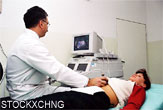First Rise in U.S. Teen Births Since '91

ATLANTA (AP) — In a troubling reversal, the nation's teen birth rate rose for the first time in 15 years, surprising government health officials and reviving the bitter debate about abstinence-only sex education.
The birth rate had been dropping since its peak in 1991, although the decline had slowed in recent years. On Wednesday, government statisticians said it rose 3 percent from 2005 to 2006.
The reason for the increase is not clear, and federal health officials said it might be a one-year statistical blip, not the beginning of a new upward trend.
However, some experts said they have been expecting a jump. They blamed it on increased federal funding for abstinence-only health education that doesn't teach teens how to use condoms and other contraception.
Some key sexually transmitted disease rates have been rising, including syphilis, gonorrhea and chlamydia. The rising teen pregnancy rate is part of the same phenomenon, said Dr. Carol Hogue, an Emory University professor of maternal and child health.
"It's not rocket science," she said.
At the same time, some research suggests teens are using condoms far more often than they did 15 years ago.
Get the world’s most fascinating discoveries delivered straight to your inbox.
The new teen birth numbers are based on the 15-19 age group of women, which accounted for most of the 440,000 births to teens in 2006. The rate rose to nearly 42 births per 1,000 in that group, up from 40.5 in 2005. That translates to an extra 20,000 births to teen mothers.
In 1991, the peak year for teen births, there were nearly 62 births per 1,000.
The new report is based on a review of more than 99 percent of the birth certificates from last year by the U.S. Centers for Disease Control and Prevention.
The report, released Wednesday, quickly took on political implications.
Opponents of abstinence-based programs seized on the data as evidence of wrong-headed government policy.
"Congress needs to stop knee-jerk approving abstinence-only funding when it's clear it's not working," said U.S. Rep. Diana DeGette, D-Colo., who is pushing for more comprehensive sex education.
The new report offers a state-by-state breakdown of birth rates overall. Many of those with the highest birth rates teach abstinence instead of comprehensive sex education, according to the Planned Parenthood Federation of America.
And research has concluded that abstinence-only programs do not cause a decrease in teenage sexual activity, Planned Parenthood officials added.
"In the last decade, more than $1 billion has been wasted on abstinence-only programs," said Cecile Richards, the organization's president, in a prepared statement.
Decreased condom use and increased sexual activity are two likely explanations for the higher teen birth rate. But not all data supports those theories, said John Santelli, a professor of population and family health at Columbia University's school of public health.
For example, a biannual government survey of high school students found that the percentage of those who said they used a condom the last time they had sex rose to 63 percent in 2005, up from 46 percent in 1991.
Contraceptive-focused sex education is still common, and the new teen birth numbers reflect it's failing, argued Moira Gaul of the Family Research Council, a conservative advocacy organization in Washington, D.C.
The CDC also reported that births to unwed mothers reached an all-time high in 2006, but that is part of a continuing upward trend and was expected.
Health officials cautioned that the rise in teen births is not the chief cause of births to unwed mothers, however. Women in their 20s and 30s represent the largest proportion, with teens accounting for fewer than a quarter, said Stephanie Ventura, head of the CDC's reproductive statistics branch.
About thirty years ago, more than half of unwed mothers were teenagers, she said.
The report on births also showed:
- That the U.S. fertility rate is at the highest level since 1971, at 2.1 children. That is an increase of 2 percent from 2005 to 2006.
- Total births rose 3 percent to nearly 4.3 million in 2006.
- Rate of Caesarean section deliveries also rose 3 percent, setting a new record of 31 percent of all births. Health officials say the rate, which has risen by about half since 1996, is higher than is medically necessary.
The high C-section rate is believed to at least partly explain why rates of preterm and low-weight births also rose in 2006. Planned deliveries, including those involving C-sections, are often done before a pregnancy comes to full term, health experts said.
- Video: Sex and the Senses
- The Sex Quiz: Myths, Taboos, and Bizaare Facts
- The Downside to Virginity Pledges


